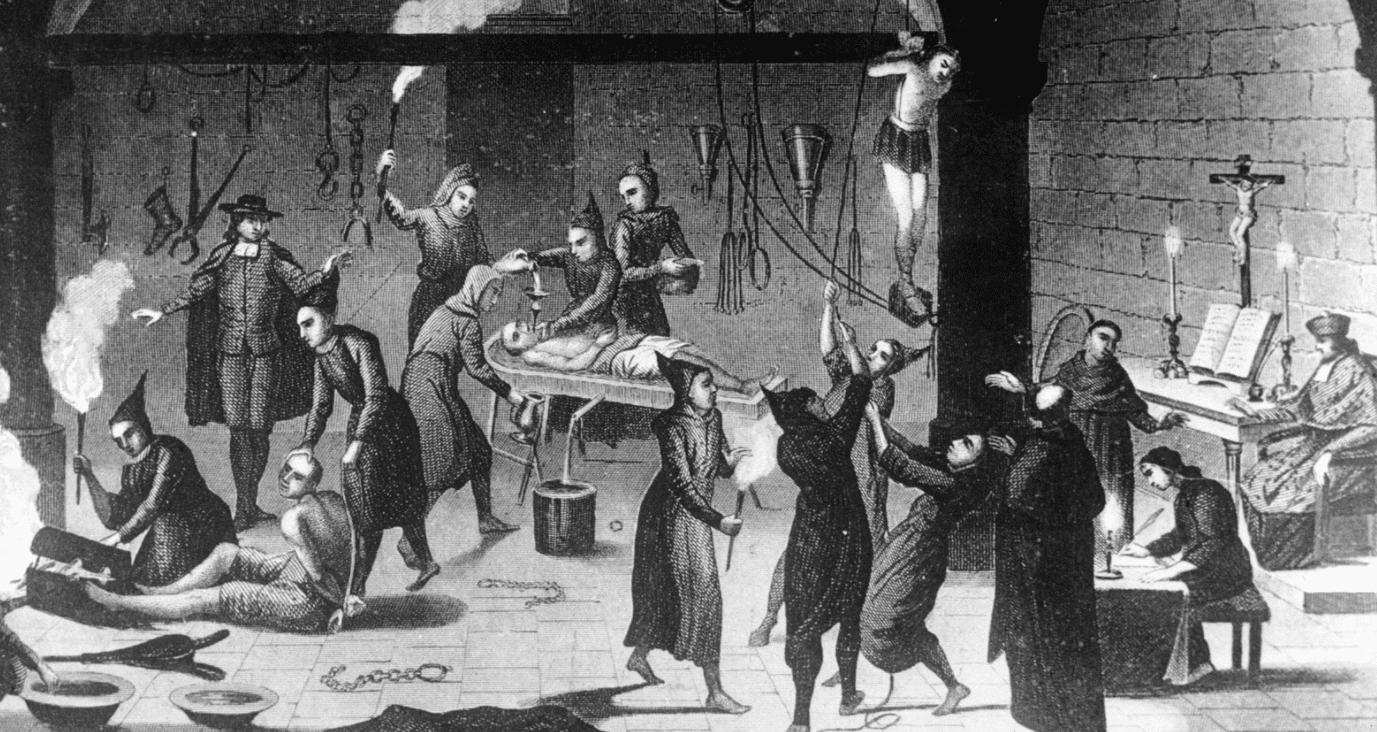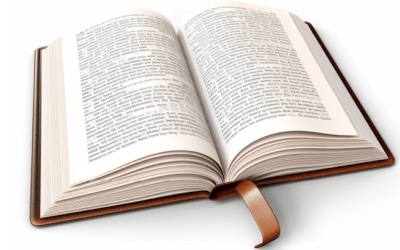The Inquisition is the institutional practice of specially appointed Roman Catholic priests charged with investigating and putting on trial individuals suspected of “heresy” (holding to beliefs and practices that were considered to be a threat to, or significantly out of line with, official Roman Catholic teaching). This system was used by the Roman Catholic Church from around the 12th century all the way up until the early 20th.1 Those convicted of heresy by the Inquisition were typically turned over to civil authorities to carry out their determined sentences, up to and including death.2 By the 16th century and the dawn of the printing press, the Inquisition was also closely connected with the systematic effort to suppress books and pamphlets considered heretical and to impose legal restrictions on a publication that would prevent such works from being printed in the first place.3
A brief history of the inquisition
The Inquisition was first established in the middle ages with the primary purpose of combating the teachings of a group known as the “Cathars” or sometimes as the “Albigenses.”4 This widespread religious movement in Western Europe is reported to have taught a form of dualism, believing in two equal and opposite divine beings, one of light and goodness, the other of darkness and corruption.5 They were considered such a threat to the Roman Catholic identity of Europe that there was even a Crusade against certain cities that were sympathetic to the Cathars.6 It is primarily in this context that the papacy first began the process of assigning specially trained and chosen priests to investigate the beliefs of those in select areas suspected of Cathar influence and to condemn all found to hold Cathar beliefs. They were likewise to punish those convicted of aiding the Cathars in any way.
At this time, the Inquisition consisted of small, largely independent teams of only a few priests.7 Each group worked alongside local governments in their assigned area and rarely interacted directly with other inquisitors.8 They were linked mostly through an innovative system of carefully indexed and shared documents and records, facilitated by Rome. This system allowed for one inquisitor to more easily discover if an accused individual had been tried before by another Inquisitor and if so to use those records to catch him in any inconsistent testimony.9
Once set in motion, the Inquisition did not limit itself to the Cathars alone. It tried and convicted doctrinal heretics, accused witches,10 and served in the suppression of a religious military group known as the “Knights Templar” in France.11
In 1478, Pope Sixtus IV established a new Inquisition, particularly in Spain, in response to growing concern that many Jews who had professed conversion to Christianity were in fact still secretly holding to their Jewish beliefs and practices. He granted Catholic Kings the authority to appoint three inquisitors in every town12 to address the issue, a power previously reserved for the Pope himself. On this basis, the Spanish Inquisition was formally organized by the Spanish crown in 1480.13 The Spanish Inquisition was more intense than previous inquisitions, in part, because it was more secular. This is not to imply that the religious elements were in any way removed, or that politics was not ever involved in previous activities of the Inquisition, but when the crown received direct authority over the institution, it freely utilized it for purposes that distant Rome would not. The Spanish employed the trials of the Inquisition to gather galley slaves for its navy and expanded the crimes the Inquisitors were to address beyond heresy to things like smuggling and horse theft.14 They were so notorious for seizing the property of the accused that the Pope himself wrote a formal rebuke to King of Spain bemoaning that he “has for some time been moved not by zeal for the faith and the salvation of souls but by lust for wealth.”15 Indeed, many cultural divides within Spanish life were swept up into the agenda of the Spanish Inquisition. As one historian notes:
“Unlike earlier inquisitions, the Spanish Inquisition was bound up not only with religious concerns, but with an ideology of ethnicity – the notion of Limpieza de Sangre, or ‘purity of blood.’ It was about classes of people rather than just categories of belief. And unlike earlier inquisitions, the was a wholly-owned subsidiary of the State.”16
Meanwhile, the Pope continued directing inquisitions elsewhere, especially in the papal states (territories in which the Pope was himself the sovereign political leader as well as the head of the Church, primarily in Italy). After the dawn of the Reformation in the 16th century, these efforts were centralized (and intensified) into a formal organization headquartered in the Vatican.17 Indeed, persecution of Protestants was more violent and thorough in Italy, where ideology was the primary focus than in the national Inquisitions like Spain, where ethnic and political concerns could be more fierce.18 Large numbers of religious dissidents from both Spain and the Papal States began to flee as refugees to the newly formed Protestant lands in Germany and Switzerland where they could escape the Inquisition’s hand.19
While the interrogation and condemnation of heretics remained a significant part of its work, the dawn of the printing press created a new focus on suppressing documents that would spread such teachings. This took hold first in the Papal lands, but Spain and others gradually followed suit in producing lists of banned books to be rooted out and in screening the publication of new works.20 The formal inquisition under the Papacy, headquartered in the Vatican, continued to operate until the early 20th century. In fact, while they no longer employ the penal methods of the Inquisition and there isn’t an official index of banned books anymore, the institutional body in the Vatican still technically exists today under the name “The Congregation for the Doctrine of the Faith.” As such, it still must evaluate and sign off on any document coming from the Vatican before publication, and it still serves to define, identify, and judge instances of heresy within the Roman Catholic communion.21 (Though, of course, today neither the heretic nor his books run any risk of being set ablaze by them.)
Pain and punishment

Neither the text of Scripture nor Protestant theology could allow for the ordaining and organizing of a body of special agents of the church to seek out heretics by wit or force and deliver them up for punishment wherever they may be.22 This does not, however, mean that all Protestants immediately rejected the idea of formal persecution.
While the Inquisition was responsible for the execution of thousands of men and women,23 it did not execute people directly. After trying them, it handed its condemned over to the civil authorities to carry out the punishment. As such, it largely relied on the execution methods already in place.24 The executions of the Inquisition were indeed quite brutal; however, this was not by peculiar design of the Inquisitors but rather because nearly all executions of those days were brutal. In the 19th century, the condemned of the Inquisition were executed by hanging rather than by methods like burning at the stake25 because hanging was by then the standard method of most executions.
Still, the Inquisition did come to attach theological significance to the idea of burning a heretic, such as its public picture to observers of the fiery torments of hell and the symbolic idea of erasing the heretic entirely from memory.26 They even attempted to erroneously argue for it biblically in passages like John 15:6. 27 The Inquisition would even exhume the bodies of those already dead and buried if they were later determined to have been heretics, and burn the remains publically.28 Thus, it is not by accident that “burning at the stake” is the method that came to define the Inquisition in most people’s minds both then and now. It certainly became the Inquisitions preferred method. This is seen even in the title of early Protestant criticism of the practices of the Inquisition, “Concerning Heretics and Those Who Burn Them.” 29
The interrogation of the accused was among the central duties of the Inquisitors. They became surprisingly skilled in human psychology as they observed, documented, and shared with one another their discoveries on the various ways that people deflect questions and conceal information.30 They also developed psychological strategies of their own to draw out information through the interrogation process, strategies quite similar to what interrogators still utilize today.31
The most notorious of the inquisitors’ tools in extracting information, however, was the use of various forms of physical torture. Again, the inquisitors did not perform the torture with their own hands. They brought in the local civil authorities to do so while the Inquisitors asked the questions.32 Accordingly, the methods used were those methods already existing in medieval Europe and familiar to the local governments.33
Torture was not utilized by the Inquisition to punish a known heretic, but rather to seek a confession from a suspected heretic.34 It was a form of interrogation and was therefore inevitably used on the innocent as well as the guilty. The crime of heresy being one purely within oneself, the only definite way to determine your guilt was for the accused to admit it. Therefore confessions were of utmost importance to the Inquisition.35 The goal was not to force the innocent to confess falsely but to compel confession only from the guilty, and therefore certain steps were taken:
- The accused were often not told what they were charged with, lest they falsely confess to the charge just to make the pain stop.36
- A confession made during torture was also inadmissible as evidence. The person had to repeat the confession again later.37
- A defendant was only officially allowed to be tortured once so that they did not repeat the confession only out of fear of further torture (though this last rule was twisted or outright broken frequently)38
Many of those who suffered torture and were released uncharged, or who were convicted but punished with a lesser sentence and released alive, fled to Protestant lands for refuge and published their stories.39
The Reformation and the Inquisition
When the Protestant Reformation turned people back to the word of God as the final authority and the theological foundations of the gospel of salvation by God’s grace alone through faith alone, it had implications in almost all areas of life and faith.
The Swiss Reformation, beginning under Ulrich Zwingli,40 supported local governments in their decision to persecute a group of more radical Protestants known as the Anabaptists. These dissenters rejected infant baptism in favor of the view that the church consisted only of those who repented of their sins and received baptism as a conscious outward expression of their inward conversion. The Anabaptists also taught extreme nonresistance, which meant they opposed violence so adamantly that they refused to serve as soldiers in legitimate defense of their land or even be political leaders because they would have to order the use of force upon criminals or in military action.41 Local governments saw these things as seditious, as threats to social unity and the security of their country, and so they sought to suppress them by force. In the beginning, the Swiss reformers generally agreed.42
The Swiss Anabaptists received life imprisonment43or execution by drowning.44 Indeed, many Protestant lands did not begin as places overly hospitable to certain kinds of dissenters, though in most cases the concern was with forms of dissent that were believed (rightly or wrongly) to harm the security or order of the civil society.45 Yet the return to biblical theology in the Reformation presented a huge challenge to these ideas of formal persecution, and would prove in many places to be its undoing. Indeed, it would challenge such institutional suppression throughout the world.46
Martin Luther, considered by most to be the founder of the Protestant Reformation, himself spoke against formal persecution, saying that the burning of heretics was contrary to the will of the Spirit.47 The Lutheran territory of Strasburg took this to heart and formally tolerated dissenters like the Anabaptists.48 It is true that the Swiss Reformation under John Calvin remained harsh toward heretics49, and Calvin is famous for his consent to the burning of the anti-Trinitarian heretic Michael Servetus.50 When the Calvinistic Reformation spread to Holland, however, it would transform Dutch society so that by the 17th century it was a place without a “state church” and where most religious expressions were permitted under the law.51 The Anabaptists spoke and wrote boldly in defense of the freedom of conscience52 and a century later the birth of the Baptist churches in England would bring still another wave of biblical argumentation for religious liberty.53 Through the consistent work of they and many other English Christians, in 1689 England took a major step in that direction with the passage of the “Act of Toleration.”54 The biblical foundation of the Reformation ultimately compelled Protestantism to reject the use of compulsion and persecution, and it became a powerful and effective voice for religious liberty.
Conclusion
The Inquisition was a Roman Catholic institution born in the Middle Ages and carried on through much of the modern era, whereby ordained church authorities were trained to specialize in the investigation of heretical beliefs and to cooperate with local governments to see them punished. Using the penal methods of the day, their punishments were often as brutal as the age around them, and torture was often employed in a regulated fashion to compel confession from those under investigation. It had different expressions in different times and places and was arguably at its worst when most under the authority and direction of secular states. This institution has no basis in Scripture or the New Testament church. The Protestant Reformation’s return to the ultimate authority of Scripture over and above the authorities of the Church or tradition never allowed them to create a similar church institution. Indeed, it ultimately led them to reject legal punishment of doctrinal error and to be a leading voice in moving the convictions of the Western world in the direction of religious liberty.
References
| 1↑ | Phillip Schaff, History of the Christian Church, Volume 5 (Hendrickson Publishing, 1907) 517 |
|---|---|
| 2↑ | Ibid, 516 |
| 3↑ | Francisco Bethencourt, The Inquisition: A Global History (Cambridge University Press, 1995) 221 |
| 4↑ | Cullen Murphy, God’s Jury: The Inquisition and the Making of the Modern World (Houghton Mifflin Harcourt Publishing, 2012) 27-34 |
| 5↑ | Ibid, 27 |
| 6↑ | Ibid, 30 |
| 7↑ | Ibid, 98 |
| 8↑ | Ibid, 34 |
| 9↑ | Ibid, 41-43 |
| 10↑ | Phillip Schaff, History of the Christian Church, Volume 5 (Hendrickson Publishing, 1907) 516-517 |
| 11↑ | Cullen Murphy, God’s Jury: The Inquisition and the Making of the Modern World (Houghton Mifflin Harcourt Publishing, 2012) 63 |
| 12↑ | Francisco Bethencourt, The Inquisition: A Global History (Cambridge University Press, 1995) 35 |
| 13↑ | Ibid, 36 |
| 14↑ | Cullen Murphy, God’s Jury: The Inquisition and the Making of the Modern World (Houghton Mifflin Harcourt Publishing, 2012) 84 |
| 15↑ | Ibid, 80 |
| 16↑ | Ibid, 70 |
| 17↑ | Ibid, 11 |
| 18↑ | Francisco Bethencourt, The Inquisition: A Global History (Cambridge University Press, 1995) 374 |
| 19↑, 39↑ | Ibid, 376 |
| 20↑ | Ibid, 221 |
| 21↑ | Cullen Murphy, God’s Jury: The Inquisition and the Making of the Modern World (Houghton Mifflin Harcourt Publishing, 2012) 2 |
| 22↑, 45↑, 50↑ | Francisco Bethencourt, The Inquisition: A Global History (Cambridge University Press, 1995) 377 |
| 23↑ | Ibid, 102 |
| 24↑, 33↑ | Phillip Schaff, History of the Christian Church, Volume 5 (Hendrickson Publishing, 1907) 515 |
| 25↑ | Cullen Murphy, God’s Jury: The Inquisition and the Making of the Modern World (Houghton Mifflin Harcourt Publishing, 2012) 10 |
| 26↑ | Francisco Bethencourt, The Inquisition: A Global History (Cambridge University Press, 1995) 286 |
| 27↑ | Cullen Murphy, God’s Jury: The Inquisition and the Making of the Modern World (Houghton Mifflin Harcourt Publishing, 2012) 67 |
| 28↑ | Phillip Schaff, History of the Christian Church, Volume 5 (Hendrickson Publishing, 1907) 528 |
| 29↑ | William R. Estep, The Anabaptist Story: 3rd Edition (Broadman Press, 1996) 261 |
| 30↑ | Cullen Murphy, God’s Jury: The Inquisition and the Making of the Modern World (Houghton Mifflin Harcourt Publishing, 2012) 51 |
| 31↑ | Ibid, 51-53 |
| 32↑ | Ibid, 55-56 |
| 34↑ | Cullen Murphy, God’s Jury: The Inquisition and the Making of the Modern World (Houghton Mifflin Harcourt Publishing, 2012) 88 |
| 35↑ | Ibid, 88 |
| 36↑ | Ibid, 89 |
| 37↑, 38↑ | Ibid, 56 |
| 40↑ | William R. Estep, The Anabaptist Story: 3rd Edition (Broadman Press, 1996) 11-12 |
| 41↑ | Ibid, 40 |
| 42↑ | ibid, 40 |
| 43↑ | Ibid, 43 |
| 44↑ | Ibid, 47 |
| 46↑ | Ibid, 378 |
| 47↑ | Phillip Schaff, History of the Christian Church, Volume 5 (Hendrickson Publishing, 1907) 524 |
| 48↑, 49↑ | Ibid, 524 |
| 51↑ | Joe Early Jr., The Life and Writings of Thomas Helwys (Mercer University Press, 2009) 19 |
| 52↑ | William R. Estep, The Anabaptist Story: 3rd Edition (Broadman Press, 1996) 257-263 |
| 53↑ | H. Leon McBeth, A Sourcebook for Baptist Heritage (Broadman Press, 1990) 70-78 |
| 54↑ | Ibid, 79-81 |






